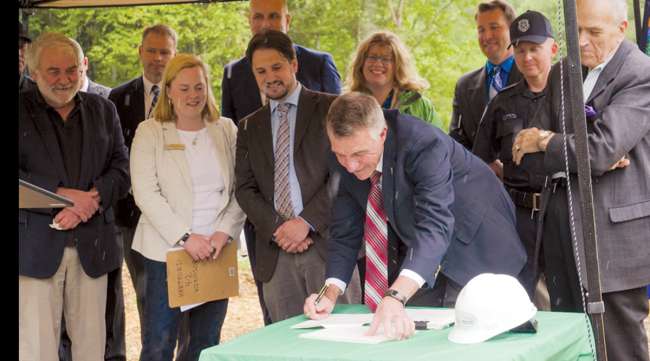Staff Reporter
Vermont Transportation Bills Address Investment, Veteran Drivers

[Stay on top of transportation news: Get TTNews in your inbox.]
Vermont Gov. Phil Scott recently signed legislation that will invest more than $600 million in the state’s transportation system and open more truck-driving opportunities for people with military backgrounds.
Scott signed two bills, one of which pertains to general transportation programs and one that relates specifically to the Department of Motor Vehicles, at a public ceremony June 14.
The bill pertaining to the DMV, Senate Bill 149, allows the commissioner to waive the knowledge test for qualified military personnel on the passenger, tank vehicle and hazardous materials endorsements for commercial driver licenses. According to a news release issued by the governor’s office, the goal is to ease the process for recruiting commercial vehicle drivers.

Scott
State and federal government agencies have worked to facilitate trucking opportunities for veterans during the past year. In late September, FMCSA announced a rule that allows state driver’s licensing agencies to waive the requirement of the commercial learner’s permit for individuals who worked in a military position that required operating a truck within the past year. Specifically, the rule says that state licensing agencies may waive the tests required for passenger carrier endorsements, tank vehicle endorsements or hazardous material endorsements if they are supplied with proof of training and experience.
The bill also allows the commissioner to accept licenses from other jurisdictions with similar exam requirements for drivers who are new to Vermont and directs the DMV to translate apps and forms into the primary language of any applicant.
“This year’s transportation bill continues our commitment to maintaining the state’s transportation system assets, providing safe highways for the traveling public and making investments in efficient transportation options for those traveling in the state by electric vehicle, bus, train, walking or biking,” Transportation Secretary Joe Flynn said in a statement. “Additionally, we will continue to improve customer service at our DMV offices statewide through modernization efforts such as our new driver’s license and enhanced translation services.”
House Bill 529, which deals broadly with transportation programs across the state, outlines a budget plan without instituting any new taxes or fee increases. The budget allocates $373 million for highway infrastructure investments. This sum includes nearly $100 million for bridge investments, $100 million for paving, $50 million for roadway projects and $20 million for traffic and safety investments.
Projects that will be supported by this funding include the reconstruction of Main Street in Waterbury, a bypass project in Essex Junction and the continuation of projects along U.S. Route 7 in Brandon and Pittsford.
The legislation also devotes $93 million to public transit, aviation and pedestrian and rail projects, including the extension of Amtrak service to downtown Burlington.
Also included in the bill are investments meant to reduce greenhouse gas emissions, fossil fuel use and household transportation costs in order to meet the goals of the Vermont Comprehensive Energy Plan.
“The investments in this legislation will continue to improve our state’s infrastructure while making transportation safer and easier for all Vermonters,” Scott said in a statement. “I want to thank the House and Senate Transportation Committees and my team at the Agency of Transportation for their work on this legislation.”
The signing ceremony took place near the bridge that carries State Route 12 in the town of Bethel, some 30 miles south of Montpelier. The bridge, a two-lane span constructed in 1928, is nearing the end of its useful design life. The Vermont Agency of Transportation has identified the need to replace the bridge.




